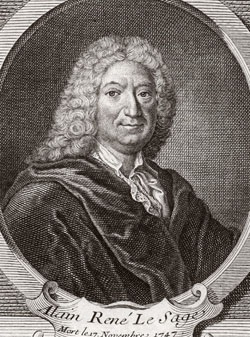ALAIN-RENÉ LESAGE
Alain-René Lesage (1668-1747) was a French novelist and playwright. He was born in Sarzeau and was educated by the Jesuits before going on to study Law in Paris. Having lost his family fortune in various ways, he tried to earn a living by writing and translating, mainly translating Spanish theatre plays. His acquaintance with Spanish literature influenced his own writing. In 1704 his first successful novel appeared, entitled Le diable boiteux, and some years later he earned acclaim for his play Turcaret ou le financier (1709). His greatest novel Histoire de Gil Blas de Santillane appeared in three volumes between 1715 and 1735. It is a picaresque novel with an adventurous hero falling from one intricate situation into another, while wandering through Spain in search of fortune. It is a rich portrayal of human inclinations and morality, tainted with the influence of the Thousand and one nights.
The fragments:
Although it has never been established with certainty, it is assumed that Lesage was involved in the publication of Galland’s Mille et une nuit, or, more accurately, in the editing of the tales submitted to the publisher by Galland’s colleague Pétis de la Croix, which were incorporated in the Mille et une nuit, without Galland’s knowledge. It would appear that Pétis de la Croix asked Lesage to improve the language of his translation of the tales. Moreover, it is not unlikely that Lesage also edited Pétis de la Croix’s own cycle Les mille et un jours, to make the style more attractive to the general audience. In the novel Histoire de Gil Blas de Santillane (1715-1735) we can see the influence of the Nights in several episodes, especially in Book V, when Don Raphael tells the story of his abduction by Algerian corsairs. The love affair with the Moorish lady, and especially his being smuggled into the harem, is reminiscent of similar scenes in the Nights. Lesage also followed stories from the Mille et une nuit and Mille et un jours in his farcical plays, or ‘Arlequinades’, a genre which was popular in France, England and the Dutch Republic. Here a fragment is included of the play La statue merveilleuse, inspired from the story of ‘Zeyn al-Asnam’, an ‘orphan story’ of Galland’s Mille et une nuit, contributed by Pétis de la Croix and possibly edited by Lesage.

Sources/references:
Francis Assaf, Lesage et le picaresque, A.-G. Nizet, Paris 1983.
Christelle Bahier-Porte, La poétique d’Alain-René Lesage, Honoré Champion, Paris 2006.
Leo Claretie, Lesage romancier, Colin, Paris 1890.Roger Laufer, Lesage; ou le metier de romancier, Gallimard, Paris 1971.
Jacques Wagner, Lesage écrivain (1695-1735), Rodopi, Amsterdam/ Atlanta 1997.
Christelle Bahier-Porte, ‘Introduction’, in: id./ Pierre Brunel (eds.), Francois Pétis de la Croix, Les mille et un jours, contes persans, Honoré Champion, Paris 2011, pp.27-75.
Ulrich Marzolph/ Richard van Leeuwen (ed.), The Arabian nights encyclopedia, 2 vols., ABC-Clio, Santa Barbara etc. 2004.
Isabelle Martin, ‘Usage et esthétique du miroir dans une pièce orientale: La Statue merveilleuse de Lesage,’ L’Esprit créaeur, vol. 39, no. 3 (Fall 1999), pp. 47-55.
Dominique Lurcel, Le theatre de la foire au XVIIIe siècle, Union Générale d’Éditions, Paris 1983.
Weblinks:
http://viaf.org/viaf/29536937 (Fichier d’Autorité International Virtuel)
http://catalogue.bnf.fr/ark:/12148/cb11912638w (Bibliothèque Nationale de France)